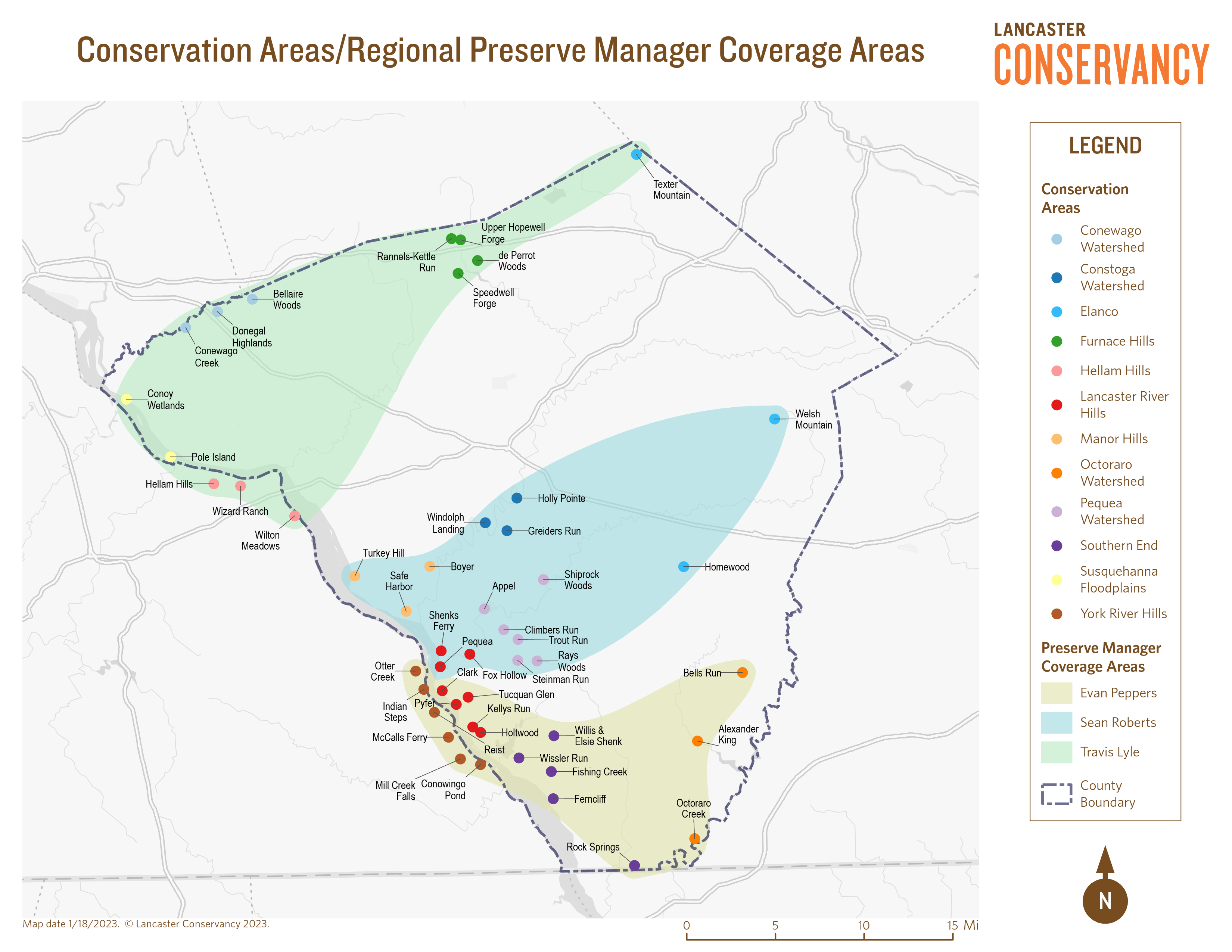With 50 nature preserves and over 40 miles of trails, the Lancaster Conservancy has a lot of land to take care of, which involves everything from installing and maintaining trails and restoring habitat to mowing grass and repairing equipment.
Because the Conservancy’s work covers preserves over a large area that spans Lancaster County and includes part of York County along the Susquehanna River, explains Lancaster Conservancy Senior Preserves Manager Steve Mohr Jr., the preserves are divided into three regions that are each managed by a Regional Preserves Manager. This makes caring for the preserves more efficient and allows each regional manager to coordinate stewardship work and maintain the preserves in his region.
Travis Lyle manages the northern region, which includes northern York and Lancaster counties. Sean Roberts is the Regional Preserves Manager for the central region, which encompasses most of the Pequea watershed and includes Climbers Run and Welsh Mountain Nature Preserves. And Evan Peppers manages the southern region, which includes southern York and Lancaster counties.
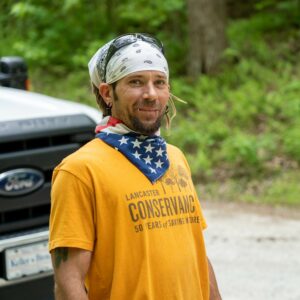
Photo by Nick Gould
Travis Lyle, Northern Regional Preserves Manager
Q: What is your favorite preserve in your region and why?
A: My favorite preserve in the northern region right now is Wizard Ranch Nature Preserve. There are lots of exciting things happening there including the installation of a brand-new trail system and some major restoration projects. It is awesome to be in the field to see the dramatic changes from very poor conditions in the woods, agriculture fields, and wetlands to more sustainable natural conditions.
Overall, the forest was in such bad shape because the dominant tree species was ailanthus (tree of heaven), and there was a lot of it! All the trees were covered in multiple large Oriental bittersweet vines which were pulling them down and collapsing the canopy. That was bad enough, but the understory was full of multiflora rose, bush honeysuckle, and privet thickets, which barely left room for a few spicebush and pawpaw.
The wetlands and creek restoration are needed due to the fragmentation of the wetlands which cause them to not function properly. The wetland area effects the channeling of the stream creating steep banks and soil loss into the nearby river.
The restoration of the hay-producing agriculture fields into successional grassland meadows will not only support more native fauna, it will also positively affect the ability of the land to absorb water more naturally.
Q: What makes this region unique?
A: The northern region includes the highlands, which have a unique geological makeup for the area. The mineral composition led to the historic use of furnaces and kilns all over the area. Some remnants remain of the furnaces, mining operations, and trails and structures used for transport of the ores, even along the river. Today we work to preserve the history and restore these areas to a more preindustrial state.
Q: What is one of the biggest stewardship challenges you face as you care for your region?
A: I think one of the biggest challenges we face stewarding these natural areas presently is the pressure from invasive species, which many times outcompete our native flora by growing and spreading quickly. The other big one to me is trying to balance the need for access to natural areas for all to use for recreation while still being able to protect wildlands from overuse and provide much needed habitat areas and wildlife corridors.
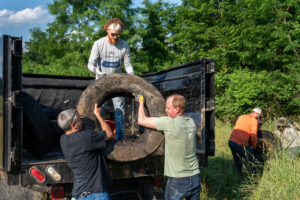
2022 Wizard Ranch workday. Photo by Greg Smolin
Q: What are some projects happening in your region this year that you are excited to work on?
A: There are so many great ones that we are trying to take on with the help of all our staff and volunteers. If I must pick just one, it would be the projects at Wizard Ranch. We recently acquired the property, and after major planning efforts, we are installing an entirely new trail system, improved public access, and major restoration projects of wooded areas, wetlands, and meadows. Staff and teams of volunteers have been removing invasive plant communities and helping with large-scale replanting to restore the site. The restoration work will re-establish native plant communities and attract wildlife while helping to clean the water of a tributary which flows directly into the Susquehanna River. We hope in the future this preserve will also become our education center in York County.
 Sean Roberts, Central Regional Preserves Manager
Sean Roberts, Central Regional Preserves Manager
Q: What is your favorite preserve in your region and why?
A: My favorite preserve in the Central Region is Trout Run. Many of this region’s preserves have long-lasting signs of human impact. I see Trout Run as the most untouched and natural setting. You are surrounded by nothing but natural sights, smells, and sounds. (Possibly even tastes and touches!) Even the sometimes-difficult trail through the gorge has few signs of the human hand. Unfortunately, erosion into the stream bank is a sign of human impact. This will be an exciting project to work on improving, while also keeping the landscape as natural as possible.
Q: What makes this region unique?
A: The Pequea Creek headwaters start all the way at Welsh Mountain Nature Preserve. It’s interesting to see the creek change by the time it makes it to Fox Hollow Nature Preserve, right before entering the Susquehanna River. When I’m out on Conservancy land, I enjoy the work our preserves are doing protecting this natural resource and others.
Q: What is one of the biggest stewardship challenges you face as you care for your region?
A: The many smaller, fragmented preserves in the central region make invasive species management a challenge for sure. The lack of interior forest makes for many more acres of invasive plants. Invasives thrive on forest edges (next to fields/lawn/roadways/utility corridors) because of the abundance of sunlight and usually disturbed soil. Interior forest has a large enough buffer of forest around it that it’s not affected by those things.
Q: What are some projects happening in your region this year that you are excited to work on?
A: I’m excited to continue the work at the Safe Harbor Nature Preserve restoration site. Eric Roper, our Forester, has implemented some awesome big restoration tree planting sites. Unfortunately, getting the tree into the ground is just the beginning. To give them a head start in their successional journey, they require a good deal of care, keeping the critter-harboring grasses at bay. The payoff should be great for the habitat and for future generations to enjoy!
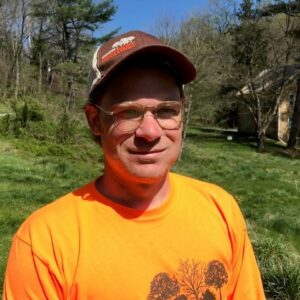 Evan Peppers, Southern Regional Preserves Manager
Evan Peppers, Southern Regional Preserves Manager
Q: What is your favorite preserve in your region and why?
A: My favorite has to be Tucquan Glen and Pyfer Nature Preserves. Along with awesome rock and water features, there are some really great trees throughout the preserve. You’re greeted by beech and poplar trees that seem to just keep getting bigger and bigger the further you hike in.
Q: What makes this region unique?
A: A large amount of the property in the southern region has had a lot of industrial infrastructure dating back to the 1700s, whether it be an old trolley line or canal, or even just old neighborhoods from the early days of the railroad and hydroelectric powerplants. With the restoration projects at Kellys Run and Clark Nature Preserves, there’s a really cool contrast of beautiful meadows of wildflowers, grasses, and new tree plantings mixed with old roads, foundations of old buildings, bridges, and some other really cool hidden features.
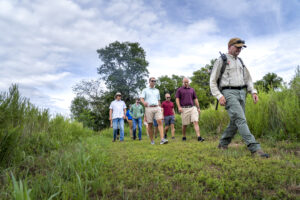
Clark Nature Preserve. Photo by Nick Gould
Q: What is one of the biggest stewardship challenges you face as you care for your region?
A: Definitely invasive species of every kind. Thanks to our Volunteer Land Stewards program, the load is definitely lighter than it could be, but it takes a TON of work to keep the trails open.
Q: What are some projects happening in your region this year that you are excited to work on?
A: I am excited to work on projects that will allow visitors to gain access to new experiences. Whether that involves improving parking or improving trails, these projects will give many people the opportunity to appreciate the preserves.
